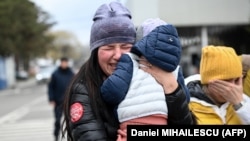On April 21, Russian President Vladimir Putin met in the Kremlin with Defense Minister Sergey Shoigu to discuss the Russian military’s assault on the Ukrainian port of Mariupol.
Russian forces launched a massive ground and aerial attack there in early March. The city on the Azov Sea had a pre-invasion population of more than 400,000. Geographically, it is key to the Kremlin’s goal of establishing a land bridge to the Crimean Peninsula, which Moscow illegally annexed in 2014.
At the meeting, Putin and Shoigu each made false or misleading claims.
For one, Putin prematurely claimed victory even though Ukrainian forces continued to fight and work to free trapped civilians at the sprawling Azovstal steel complex.
“The work of the armed forces to liberate Mariupol has been a success. Congratulations,” Putin said.
Ukrainian authorities contested Putin’s claim of victory, while acknowledging a dire situation with the city surrounded. Later, U.S. President Joe Biden also noted “there is no evidence yet that Mariupol has completely fallen.”
“We would tell you this morning is that we still assess that Mariupol is contested, that it hasn’t been taken by the Russians and that there’s still an active Ukrainian resistance,” Pentagon spokesman John Kirby told CNN on April 22. “So they continue to fight for that city.”
The damage to Mariupol from Russian missiles, bombs and shells is undeniably extensive. Speaking to the Greek parliament on April 7, Ukrainian President Volodymyr Zelenskyy said the city had been “reduced to ashes, destroyed completely. The Russian military destroyed everything.” The city’s mayor has said that while there is no definitive count, the civilian death toll could be greater than 20,000. Satellite images released on April 21 show what Ukraine officials said is likely a mass grave holding thousands.
Shoigu told Putin: “The Russian army and the people's militia units from the DPR took every precaution to save civilian lives.” (DPR stands for the Donetsk People’s Republic, one of two self-proclaimed Russia-backed breakaway provinces in eastern Ukraine, where Russia has fomented war since its 2014 invasion of Crimea.)
Vast amounts of evidence, from dead civilians to bombed out residential buildings, medical facilities, theaters and more, contradict Shoigu’s claim.
Michelle Bachelet, the United Nations commissioner for human rights, told The Associated Press on April 22: “Over these eight weeks, international humanitarian law has not merely been ignored but seemingly tossed aside.”
A statement released by her office said:
“Russian armed forces have indiscriminately shelled and bombed populated areas, killing civilians and wrecking hospitals, schools and other civilian infrastructure – actions that may amount to war crimes.”
Bachelet’s mission also “documented what appears to be the use of weapons with indiscriminate effects, causing civilian casualties and damage to civilian objects, by Ukrainian armed forces in the east of the country.”
Maxar Technologies said that the satellite images it released on April 21 also showed more than 200 mass graves in the town of Manhush outside Mariupol.
On April 22, the Mariupol city council posted on Telegram a satellite image that it said shows another mass grave in the suburban town of Vinograndne. According to the city council, an estimated 1,000 civilians killed by Russian troops could be buried in it.
Shoigu also told Putin: “Over the past two days, again as per your instructions, we declared a ceasefire between 2 p.m. and 4 p.m., stopped all military action and opened humanitarian corridors to enable civilians who may be at Azovstal to leave. We prepared about 90 buses for them, and 25 ambulances. No one left Azovstal.”
The claim of “humanitarian corridors” is misleading.
Ukrainian authorities said the Russians are deliberately targeting refugee corridors with artillery and missile strikes – unless they provide a path to Russia. On April 8, for example, Russian rockets hit the Kramatorsk train station, killing 57 people and wounding more than 100.
Russia falsely denied responsibility.
What Shoigu described as humanitarian corridors in reality are designated locations where Russians gather Ukrainian civilians for transport to “filtration camps,” and then on to Russian provinces, all without consent or choice of destination.
More than 935,000 refugees from Ukraine have been taken to Russia since February 24, Russia’s state-owned TV Channel 1 reported on April 22.
According to local media reports in Russia’s regions, the Ukrainian civilians are being placed in abandoned buildings previously used as hospitals and sanatoriums.
For example, Chuvashia, a region in Russia’s Volga River basin, is hosting 1,075 Ukrainian refugees. Some live with their Russian relatives, while most are in local sanatoriums, including the “Chuvarleisky Bor,” a children’s tuberculosis sanatorium.
More than 500,000 Ukrainians have been “forcibly transferred” to Russia, including 121,000 children, Ukraine’s Permanent Representative to the United Nations, Sergiy Kyslytsya, said on April 19.





